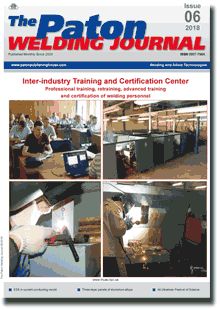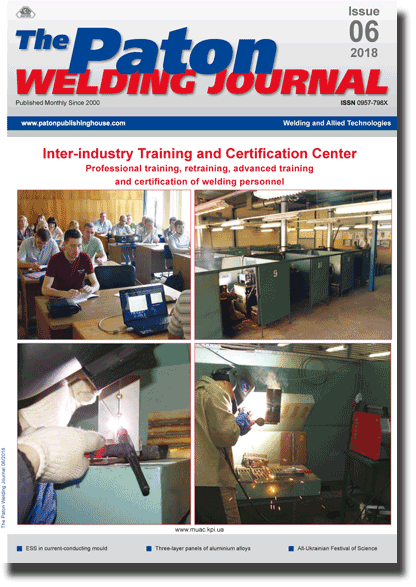| 2018 №06 (02) |
DOI of Article 10.15407/tpwj2018.06.03 |
2018 №06 (04) |

The Paton Welding Journal, 2018, #6, 20-27 pages
Influence of technological and electrical parameters of ESS in current-supplying mould
V.G. Soloviov and Yu.M. Kuskov
E.O. Paton Electric Welding Institute of the NAS of Ukraine 11 Kazimir Malevich Str., 03150, Kyiv, Ukraine. E-mail: office@paton.kiev.ua
A calculation experiment was conducted which showed that the controllable electrical parameters of the ESS process can be used to regulate the metal pool shape and electrode melting rate. Dependencies between the depth of electrode deepening into the slag pool, average depth of penetration and uniformity of base metal penetration relative to average penetration depth were determined. A method was proposed for calculation of the depth of electrode deepening into the slag pool by the ratio of currents in CSM. Comparative analysis of three types of single-circuit diagrams of the mould connection to the power source was performed, and an optimum diagram for the required criteria of surfacing quality was proposed. 8 Ref., 1 Table, 12 Figures.
Keywords: current-supplying mould, experiment, automation, metal pool, regulation, penetration, bottom plate, electrode, conductivity, diagram of power supply
Received: 30.03.18
Published: 05.07.18
References
- Troyansky, A.A., Ryabtsev, A.D., Samborsky, M.V., Mastepan, V.Yu. (2002) Application of measuring information system for investigation of ESR process. Metall i Litio Ukrainu, 7–8, 25–26 [in Russian].
- Troyansky, A.A., Ryabtsev, A.D., Mastepan, V.Yu. (2004) Indirect methods for control of ESR technological parameters based on application of harmonic composition of current and voltage of remelting. In: of Papers of Int. Scient. Conf. on Modern Problems of Theory and Practice of Quality Steel Production (Mariupol, 8-10 September 2004). Priazov. STU, 80–82.
- Troyansky, A.A., Ryabtsev, A.D., Mastepan, V.Yu. et al. (2005) Application of method of current distribution modeling as the base for development of technology of high-quality ingots by CESR method. Metallurg. Protsessy i Oborudovanie, 2, 25–27 [in Russian].
- Makhnenko, V.I., Demchenko, V.F., Tarasevich, N.I., Krikent, I.V. (1985) Calculation system for investigation of current distribution in slag pool. Problemy Spets. Elektrometallurgii, 1, 14–19 [in Russian].
- Tomilenko, S.V., Kuskov, Yu.M. (2000) Regulation and stabilization of base metal depth penetration in electroslag surfacing in current-supplying mold. Proizvodstro, 9, 32–35 [in Russian].
- Tomilenko, S.V., Kuskov, Yu.M. (1999) Power features of electroslag process in current-supplying mold. Svarka, 2, 51–53 [in Russian].
- Shmelev, V.E. Partial differential equations toolbox. Toolbox for solution of differential equations in partial derivatives [in Russian]. http://matlab.exponenta.ru/pde/book1/index.php
- Govorkov, V.A. (1968) Electric and magnetic fields. 3rd Ed. Moscow, Energiya [in Russian].
Suggested Citation
V.G. Soloviov and Yu.M. Kuskov (2018) Influence of technological and electrical parameters of ESS in current-supplying mould on electrode melting rate and base metal penetration. The Paton Welding J., 06, 20-27.The cost of subscription/purchase order journals or individual articles
| Journal/Currency | Annual Set | 1 issue printed |
1 issue |
one article |
| TPWJ/USD | 384 $ | 32 $ | 26 $ | 13 $ |
| TPWJ/EUR | 348 € | 29 € | 24 € | 12 € |
| TPWJ/UAH | 7200 UAH | 600 UAH | 600 UAH | 280 UAH |
| AS/UAH | 1800 UAH | 300 UAH | 300 UAH | 150 UAH |
| AS/USD | 192 $ | 32 $ | 26 $ | 13 $ |
| AS/EUR | 180 € | 30 € | 25 € | 12 € |
| SEM/UAH | 1200 UAH | 300 UAH | 300 UAH | 150 UAH |
| SEM/USD | 128 $ | 32 $ | 26 $ | 13 $ |
| SEM/EUR | 120 € | 30 € | 25 € | 12 € |
| TDNK/UAH | 1200 UAH | 300 UAH | 300 UAH | 150 UAH |
| TDNK/USD | 128 $ | 32 $ | 26 $ | 13 $ |
| TDNK/EUR | 120 € | 30 € | 25 € | 15 € |
AS = «Automatic Welding» - 6 issues per year;
TPWJ = «PATON WELDING JOURNAL» - 12 issues per year;
SEM = «Electrometallurgy Today» - 4 issues per year;
TDNK = «Technical Diagnostics and Non-Destructive Testing» - 4 issues per year.


